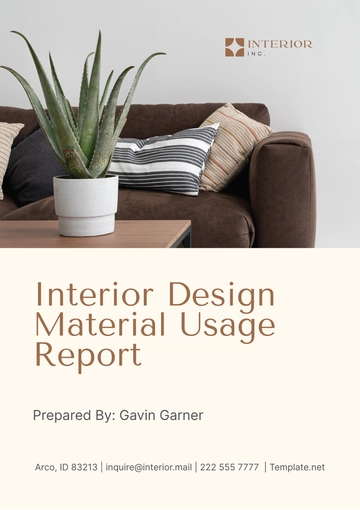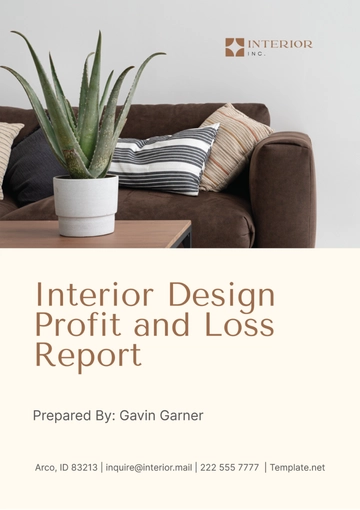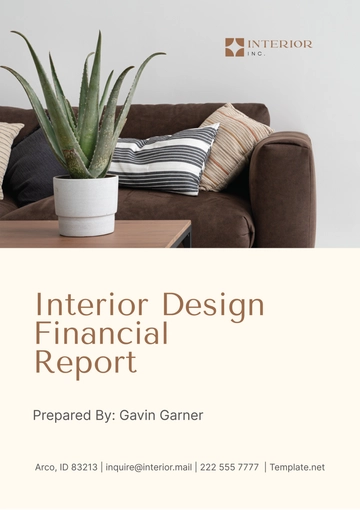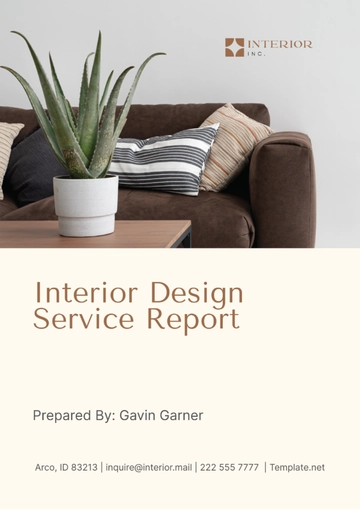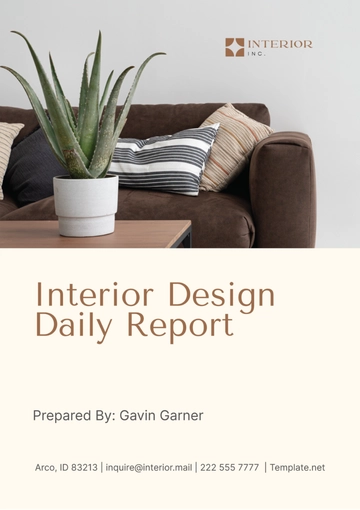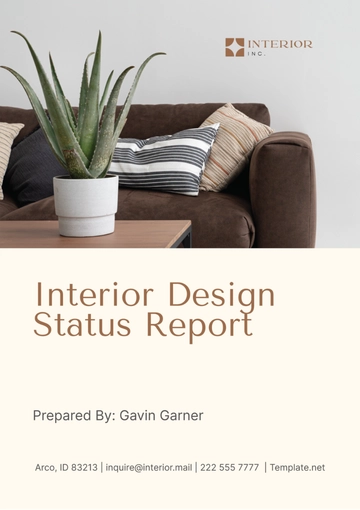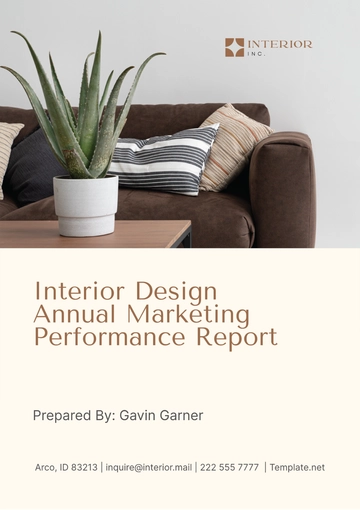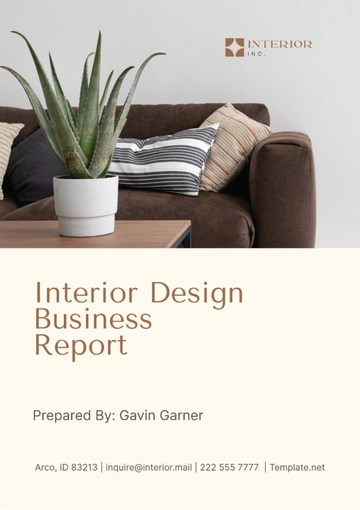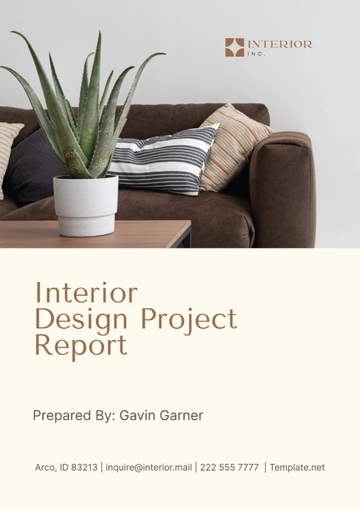Free Interior Design Profit and Loss Report
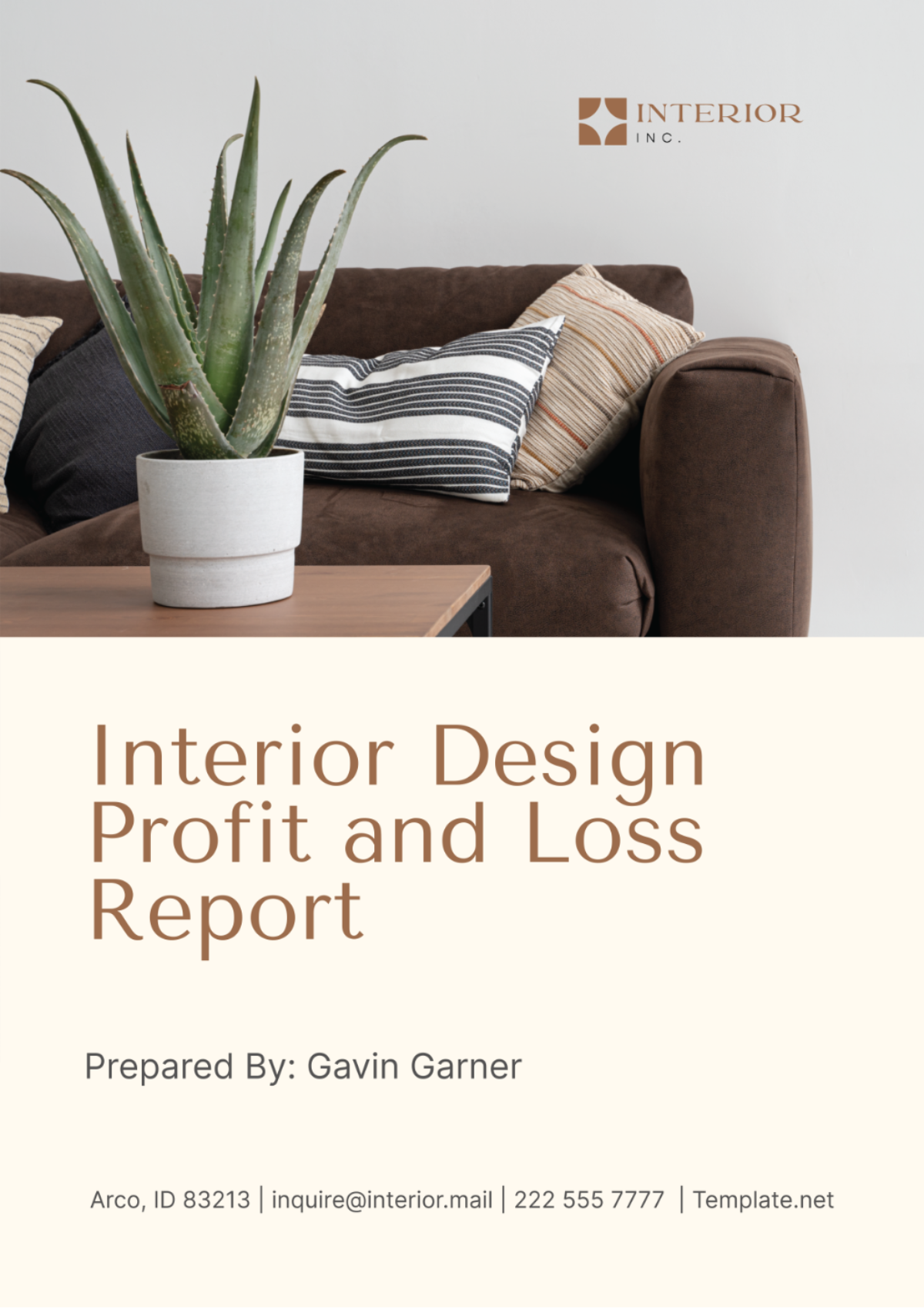
I. Introduction
A. Overview of the Reporting Period
The Profit and Loss Report enclosed herein offers an in-depth review of the financial results of [Your Company Name] for the specified period of [Month, Year]. This comprehensive documentation emphasizes the primary sources of revenue, outlines the significant areas of expenditure, and details the critical profitability indicators that collectively contribute to an evaluation of the overall financial health of the business.
B. Purpose of the Report
The fundamental objective of this report is to provide key stakeholders, such as business owners, investors, and management teams, with a detailed understanding and analysis of the financial operations within the interior design firm. Through a thorough examination of the different financial aspects, including revenue streams, cost structures, and overall profitability, this report aims to equip all relevant stakeholders with the critical information necessary to make well-informed decisions that will aid in fostering business expansion and enhancing operational efficiency.
II. Revenue
Source of Revenue | Amount ($) |
|---|---|
Client Fees | $[00,000] |
Sales of Products | $[00,000] |
Other Income | $[00,000] |
Total Revenue | $[00,000] |
Client Fees represent the primary revenue stream, comprising fees charged for interior design services rendered to clients during the reporting period. Sales of Products include revenue generated from the sale of interior design-related products or merchandise. Other Income encompasses additional sources of revenue such as consultation fees, referral commissions, or rental income.
III. Cost of Goods Sold (COGS)
Item | Amount ($) |
|---|---|
Materials | $[00,000] |
Labor | $[00,000] |
Subcontractor Fees | $[00,000] |
Other Direct Costs | $[00,000] |
Total COGS | $[00,000] |
Materials expenses include the cost of purchasing materials and supplies required for interior design projects, such as furniture, fabrics, and decor items. Labor costs encompass wages paid to in-house designers and craftsmen involved in project execution. Subcontractor Fees represent payments made to external contractors or specialists hired to perform specific tasks, such as carpentry or installation. Other Direct Costs cover miscellaneous expenses directly associated with project delivery, such as transportation or permits.
IV. Gross Profit
Description | Amount ($) |
|---|---|
Total Revenue | $[00,000] |
Total COGS | $[00,000] |
Gross Profit | $[00,000] |
Gross Profit is calculated by subtracting the Total COGS from the Total Revenue and represents the profit generated from core business operations before accounting for operating expenses. A positive Gross Profit indicates that the interior design firm's revenue exceeds the direct costs associated with delivering its services and products.
V. Operating Expenses
Expense Category | Amount ($) |
|---|---|
Rent | $[00,000] |
Utilities | $[00,000] |
Salaries and Wages | $[00,000] |
Marketing Expenses | $[00,000] |
Insurance | $[00,000] |
Office Supplies | $[00,000] |
Other Admin Costs | $[00,000] |
Total Operating Expenses | $[00,000] |
Operating Expenses encompass the day-to-day costs of running the interior design firm's business operations. Rent represents the monthly lease payment for office or studio space used for client meetings and design work. Utilities cover expenses such as electricity, water, and internet services necessary for office operations. Salaries and Wages include compensation paid to employees, including designers, administrative staff, and support personnel. Marketing Expenses encompass promotional activities aimed at attracting clients and enhancing brand visibility. Insurance covers various types of insurance policies, such as liability insurance and property insurance, to protect the business against potential risks. Office Supplies include expenditures on stationary, printing materials, and other office essentials. Other Admin Costs encompass miscellaneous administrative expenses not classified under specific categories.
VI. Net Profit
Description | Amount ($) |
|---|---|
Gross Profit | $[00,000] |
Total Operating Expenses | $[00,000] |
Net Profit | $[00,000] |
Net Profit is calculated by subtracting Total Operating Expenses from Gross Profit and represents the final profit after considering all expenses associated with running the business. A positive Net Profit indicates that the interior design firm has earned more revenue than it has incurred in operating expenses, resulting in a profitable outcome for the reporting period.
VII. Financial Performance Metrics
A. Gross Profit Margin: 33.33%
Gross Profit Margin is calculated by dividing Gross Profit by Total Revenue and multiplying by 100. It measures the percentage of revenue retained by the business after accounting for the direct costs of goods sold. A higher gross profit margin indicates greater efficiency in managing production costs. The current gross profit margin of 33.33% is consistent with industry standards, indicating healthy profitability.
B. Net Profit Margin: 1.45%
Net Profit Margin is calculated by dividing Net Profit by Total Revenue and multiplying by 100. It measures the percentage of revenue retained by the business as profit after accounting for all expenses, including operating costs and taxes. A higher net profit margin indicates better overall profitability. The current net profit margin of 1.45% reflects the interior design firm's ability to control costs effectively while generating positive returns.
C. Return on Investment (ROI): 4.35%
Return on Investment is calculated by dividing Net Profit by Total Assets and multiplying by 100. It measures the efficiency of the interior design firm in generating profit relative to the resources invested in the business. A higher ROI indicates better returns on invested capital. The current ROI of 4.35% demonstrates the firm's ability to generate satisfactory returns for its stakeholders.
D. Key Performance Indicators (KPIs):
Client Satisfaction: Client satisfaction surveys indicate a satisfaction rate of 95% for the reporting period, reflecting the firm's commitment to delivering high-quality design solutions and excellent customer service.
Project Completion Timelines: The average project completion time decreased by 10% compared to the previous year, signaling improved project management efficiency and timely delivery of services.
Revenue Growth Targets: The interior design firm achieved a revenue growth rate of 12% compared to the same period last year, exceeding the targeted growth rate of 10% and indicating successful business expansion efforts.
Market Share: The firm maintained a stable market share of 15% in the local interior design industry, despite increasing competition, demonstrating strong brand recognition and customer loyalty.
VIII. Comparison to Previous Periods
A. Month-to-Month Comparison
Revenue increased by 8% compared to the previous month, driven by higher demand for design services and increased sales of merchandise.
Operating expenses decreased by 5% due to cost-saving initiatives implemented during the reporting period.
B. Year-to-Year Comparison
Revenue grew by 12% compared to the same period last year, primarily attributed to successful marketing campaigns and expansion into new market segments.
Net profit margin improved by 0.5% year-over-year, indicating enhanced cost management practices and operational efficiency.
C. Variance Analysis
Variance analysis revealed a 10% increase in materials costs compared to the budgeted amount, attributed to unforeseen price increases from suppliers.
Marketing expenses were 15% lower than budgeted, resulting from renegotiated contracts with advertising agencies and more targeted marketing strategies.
IX. Recommendations and Conclusion
A. Opportunities for Improvement
Explore strategic partnerships with furniture manufacturers to secure bulk discounts on materials and reduce procurement costs.
Implement digital marketing initiatives to expand the firm's online presence and attract a wider audience of potential clients.
B. Strategic Insights
Invest in employee training programs to enhance design skills and improve productivity, ultimately leading to higher client satisfaction and repeat business.
Diversify revenue streams by offering additional services such as virtual design consultations and online design courses to capitalize on emerging market trends.
C. Conclusion and Future Outlook
The interior design firm has demonstrated solid financial performance for the reporting period, with positive growth trends and improved profitability metrics. Moving forward, the firm remains committed to innovation, client satisfaction, and sustainable growth strategies to maintain its competitive edge in the dynamic interior design industry.
- 100% Customizable, free editor
- Access 1 Million+ Templates, photo’s & graphics
- Download or share as a template
- Click and replace photos, graphics, text, backgrounds
- Resize, crop, AI write & more
- Access advanced editor
Discover the ultimate financial tool for interior design firms on Template.net. Our editable and customizable Interior Design Profit and Loss Report Template offers seamless financial analysis. With the AI Editor Tool, effortlessly tailor reports to your business needs. Streamline your financial management and make informed decisions with this comprehensive template. Boost your profitability today!
You may also like
- Sales Report
- Daily Report
- Project Report
- Business Report
- Weekly Report
- Incident Report
- Annual Report
- Report Layout
- Report Design
- Progress Report
- Marketing Report
- Company Report
- Monthly Report
- Audit Report
- Status Report
- School Report
- Reports Hr
- Management Report
- Project Status Report
- Handover Report
- Health And Safety Report
- Restaurant Report
- Construction Report
- Research Report
- Evaluation Report
- Investigation Report
- Employee Report
- Advertising Report
- Weekly Status Report
- Project Management Report
- Finance Report
- Service Report
- Technical Report
- Meeting Report
- Quarterly Report
- Inspection Report
- Medical Report
- Test Report
- Summary Report
- Inventory Report
- Valuation Report
- Operations Report
- Payroll Report
- Training Report
- Job Report
- Case Report
- Performance Report
- Board Report
- Internal Audit Report
- Student Report
- Monthly Management Report
- Small Business Report
- Accident Report
- Call Center Report
- Activity Report
- IT and Software Report
- Internship Report
- Visit Report
- Product Report
- Book Report
- Property Report
- Recruitment Report
- University Report
- Event Report
- SEO Report
- Conference Report
- Narrative Report
- Nursing Home Report
- Preschool Report
- Call Report
- Customer Report
- Employee Incident Report
- Accomplishment Report
- Social Media Report
- Work From Home Report
- Security Report
- Damage Report
- Quality Report
- Internal Report
- Nurse Report
- Real Estate Report
- Hotel Report
- Equipment Report
- Credit Report
- Field Report
- Non Profit Report
- Maintenance Report
- News Report
- Survey Report
- Executive Report
- Law Firm Report
- Advertising Agency Report
- Interior Design Report
- Travel Agency Report
- Stock Report
- Salon Report
- Bug Report
- Workplace Report
- Action Report
- Investor Report
- Cleaning Services Report
- Consulting Report
- Freelancer Report
- Site Visit Report
- Trip Report
- Classroom Observation Report
- Vehicle Report
- Final Report
- Software Report
